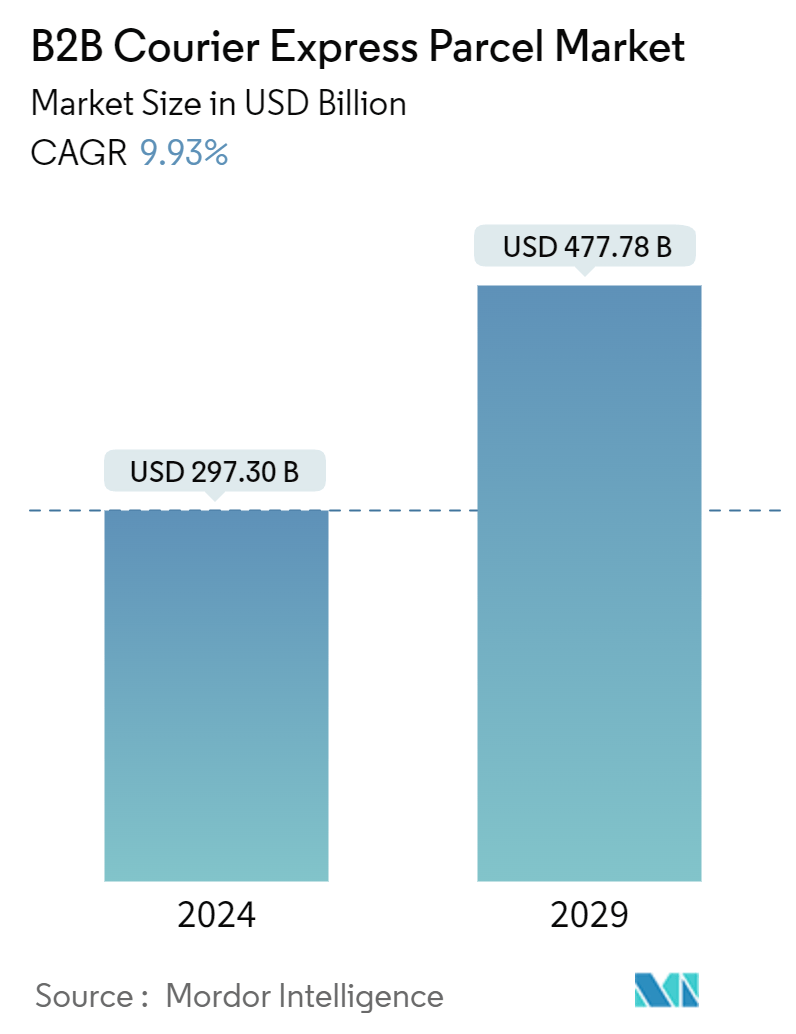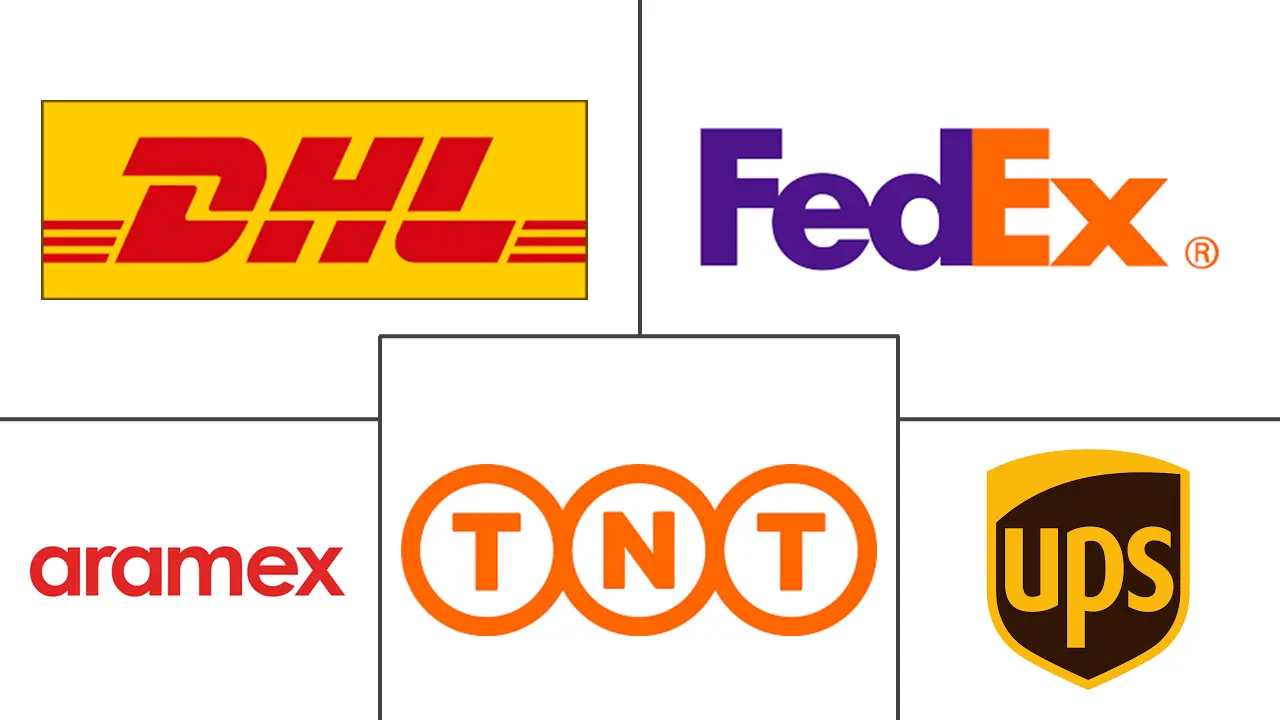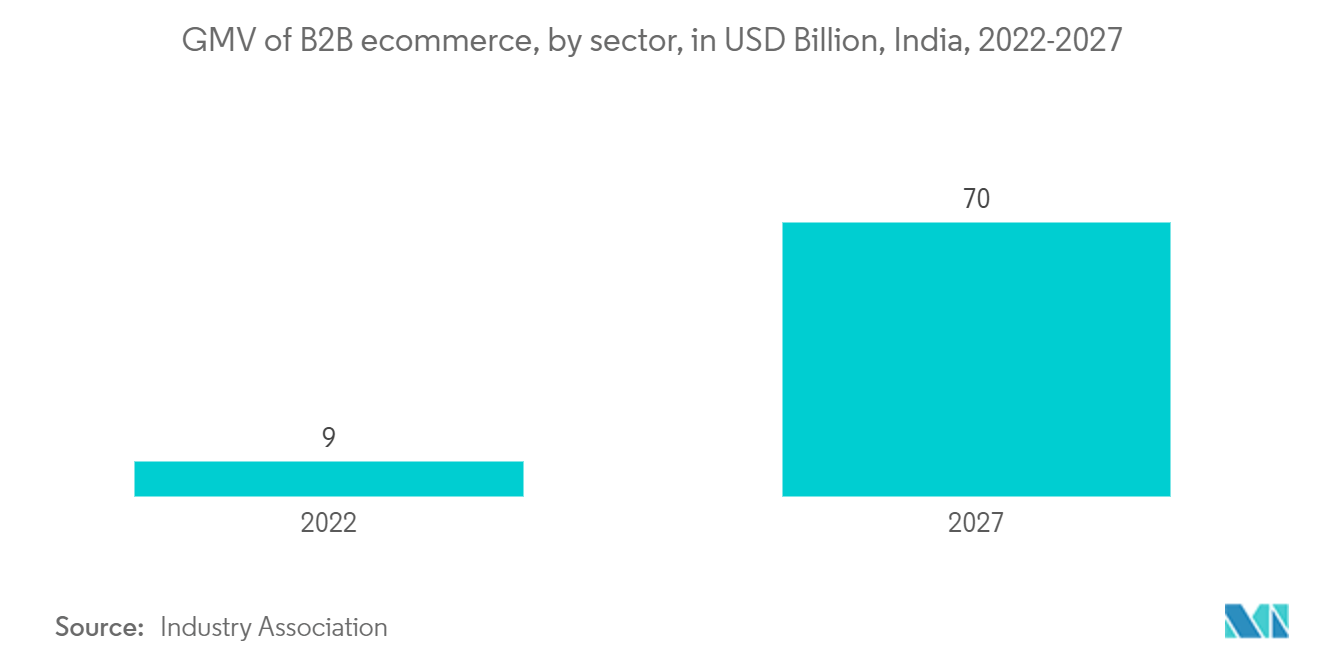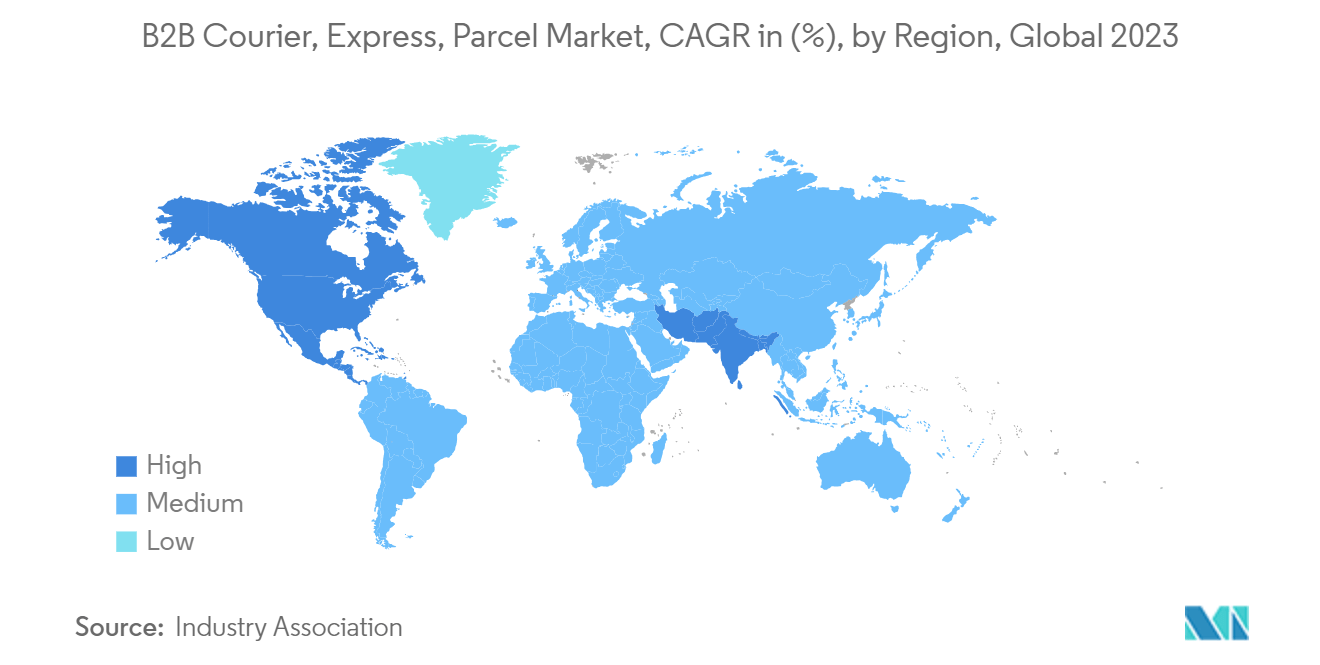B2B Courier Express Parcel Market Size

| Study Period | 2020 - 2029 |
| Market Size (2024) | USD 297.30 Billion |
| Market Size (2029) | USD 477.78 Billion |
| CAGR (2024 - 2029) | 9.93 % |
| Fastest Growing Market | Europe |
| Largest Market | Asia |
Major Players
*Disclaimer: Major Players sorted in no particular order |
B2B Courier Express Parcel Market Analysis
The B2B Courier Express Parcel Market size is estimated at USD 297.30 billion in 2024, and is expected to reach USD 477.78 billion by 2029, growing at a CAGR of 9.93% during the forecast period (2024-2029).
Vertical or specialized marketplaces are becoming increasingly popular in B2B e-commerce. These portals provide a wider variety of products in a specific category along with specific value-added services (business-to-everyone).
Companies are increasingly leveraging big data to provide a personalized customer experience. Mobile shops are becoming increasingly popular. Cloud platforms are taking over from legacy platforms that are not designed to handle such scale.
B2B e-commerce companies are also integrating their systems and platforms to create omnichannel relationships with their clients. The lack of high-quality customer data (fewer buyers and less specialized services) is slowing down personalization efforts.
The industry’s larger scale and other challenges (such as larger order sizes, variable pricing, more products, and shorter delivery times) are putting pressure on existing supply chains.
B2B e-commerce is dominated by companies such as Alibaba, Rakuten, Unite Mercateo Global Sources, Walmart India, and Amazon Business. Amazon rebranded its B2B operations from AmazonSupply. In 2015, Amazon changed its name to Amazon Business, and in just one year, it achieved sales of more than USD 1 billion. In 2022, Amazon registered a GMV (gross merchandise value) of USD 35 billion.
B2B Courier Express Parcel Market Trends
Expanding Domestic B2B CEP Segment
Domestic markets have been growing more quickly than international markets in most regions, but the gap is narrowing significantly in some regions.
The gap between the domestic and international markets is smaller in North America and Europe. In Europe, this is primarily due to the interconnectedness of the market and the lower barriers to international trade. Domestic markets have proved capable of seizing on the opportunities that e-commerce brings.
Consumer preferences constantly change, so they demand a more personalized e-commerce and logistics experience that pampers them and provides the most excellent ease from beginning to end. To meet this increased demand, logistics platforms employ technologies like AI, IoT, and Big Data to gain insights into consumer preferences and adapt their experiences.
E-commerce companies are expanding their networks in Europe to provide better services to customers. For instance, the Spanish retailer DIA is expanding its delivery services to all towns along the Spanish coastline, from Girona to Huelva, reaching more than 5 million new customers.
Courier services for healthcare products are expected to grow in the coming years in the region due to several factors, such as the increasing demand for medical supplies, rising healthcare spending, and the need for faster and more efficient delivery services.
Also, from 2023, it was expected that the total retail sales globally would grow at pre-pandemic levels and drive the growth of the market. As a result, the domestic CEP segment was expected to expand.

North America is Dominating the Market
North America’s revenue is expected to be higher than other regions. The region’s strong economy means that there is ample investment in high-tech equipment. When it comes to B2B e-commerce, the United States leads the way. The growth of the B2B sector in North America is largely due to the use of advanced technologies such as cloud computing, AI, big data & analytics, mobility / social media, cybersecurity, and IoT.
Online B2B marketplaces came into being much later than retail B2C or C2C e-commerce options in North America. The ecosystem created by these early adopters of retail channels influenced the popularity of online operations and gave rise to promising prospects for B2B e-commerce platforms. The growth of retail e-commerce platforms continues to drive the evolution of B2B online marketspaces online.
New retail or wholesale channel partners are moving their operations online. The US Census Bureau reported that e-commerce sales made up 14.8% of total sales in Q1 2022, which was a 6.8 % increase from Q1 2021. The increasing popularity of retail e-commerce shows customer preference, which drives the evolution of the ecosystem and brings new e-commerce platforms and players into the market. It also creates a new market space for B2B and its users.

B2B Courier Express Parcel Industry Overview
The B2B CEP market is quite diverse and dynamic. In this industry, several key players provide a wide range of services to businesses. One of the prominent players in the B2B CEP market is DHL.
With a strong global presence, DHL is offering a comprehensive suite of services, such as express delivery, freight transportation, and supply chain solutions. The company has robust and advanced technology that enables it to provide efficient and reliable services to businesses worldwide.
DHL Global Forwarding, the air and ocean freight specialist of Deutsche Post DHL Group, successfully implemented sustainable logistics solutions for its customer Grundfos.
B2B Courier Express Parcel Market Leaders
-
DHL
-
FedEx
-
UPS
-
TNT Express
-
Aramex
*Disclaimer: Major Players sorted in no particular order

B2B Courier Express Parcel Market News
- September 2023: The Otto Group planned to deploy Covariant robots to increase operational efficiency, build resilience against labor market challenges, and improve the overall quality of work within their fulfillment centers.
- February 2023: DPD UK, part of the DPDgroup, announced the acquisition of a longstanding final mile courier company with a fleet of circa 200 couriers serving more than 2,500 clients.
B2B Courier Express Parcel Market Report - Table of Contents
1. INTRODUCTION
- 1.1 Study Deliverables
- 1.2 Study Assumptions
- 1.3 Scope of the Study
2. RESEARCH METHODOLOGY
3. EXECUTIVE SUMMARY
4. MARKET INSIGHTS
- 4.1 Current Market Scenario
- 4.2 Government Regulations and Initiatives
- 4.3 Technological Trends and Automation in the B2B CEP Industry
- 4.4 Insights into the E-commerce Industry (Domestic and International E-commerce)
- 4.5 Insights into Startups and Venture Capital Funding in the B2B CEP Industry
- 4.6 Brief on Courier Rates
- 4.7 Elaboration on Storage Functions and Value-added Services in the B2B CEP Business
- 4.8 Insights into Reverse Logistics and Same-day Delivery Market
- 4.9 Insights into Deliveries During Festive Season (Christmas, Singles' Day, Black Friday, etc.)
- 4.10 Impact of COVID-19 on the B2B CEP Market
5. MARKET DYNAMICS
-
5.1 Drivers
- 5.1.1 E-commerce Boom
- 5.1.2 Same-day and Next-day Delivery
-
5.2 Restraints
- 5.2.1 Regulatory Challenges
- 5.2.2 Infrastructure Limitations
-
5.3 Opportunities
- 5.3.1 Last Mile Delivery Solutions
- 5.3.2 International Expansion
-
5.4 Industry Attractiveness - Porter's Five Forces Analysis
- 5.4.1 Bargaining Power of Suppliers
- 5.4.2 Bargaining Power of Consumers/ Buyers
- 5.4.3 Threat of New Entrants
- 5.4.4 Threat of Substitute Products
- 5.4.5 Intensity of Competitive Rivalry
- 5.5 Value Chain/Supply Chain Analysis
6. MARKET SEGMENTATION
-
6.1 Destination
- 6.1.1 Domestic
- 6.1.2 International
-
6.2 End User
- 6.2.1 Services (BFSI (Banking, Financial Services and Insurance))
- 6.2.2 Wholesale and Retail Trade (E-commerce)
- 6.2.3 Manufacturing, Construction, and Utilities
- 6.2.4 Primary Industries (Agriculture and Other Natural Resources)
-
6.3 Geography
- 6.3.1 North America
- 6.3.1.1 United States
- 6.3.1.2 Canada
- 6.3.1.3 Mexico
- 6.3.2 Europe
- 6.3.2.1 Germany
- 6.3.2.2 France
- 6.3.2.3 United Kingdom
- 6.3.2.4 Rest of Europe
- 6.3.3 Asia-Pacific
- 6.3.3.1 China
- 6.3.3.2 Japan
- 6.3.3.3 South Korea
- 6.3.3.4 India
- 6.3.3.5 Rest of Asia-Pacific
- 6.3.4 LAMEA
- 6.3.4.1 Brazil
- 6.3.4.2 South Africa
- 6.3.4.3 GCC
- 6.3.4.4 Rest of LAMEA
7. COMPETITIVE LANDSCAPE
- 7.1 Overview (Market Concentration and Major Players)
-
7.2 Company Profiles
- 7.2.1 DHL
- 7.2.2 FedEx
- 7.2.3 UPS
- 7.2.4 TNT Express
- 7.2.5 Aramex
- 7.2.6 SF Express
- 7.2.7 GLS
- 7.2.8 Hermes
- 7.2.9 Post Nord
- 7.2.10 Royal Mail*
- *List Not Exhaustive
- 7.3 Other Companies
8. FUTURE OF THE MARKET
9. APPENDIX
** Subject To AvailablityB2B Courier Express Parcel Industry Segmentation
The B2B courier express parcel market refers to the business-to-business courier express parcel market. It involves the transportation and delivery of packages, documents, and goods between businesses. These services are designed to be fast, reliable, and efficient, meeting the specific needs of businesses when it comes to sending and receiving shipments.
The B2B courier express parcel market is segmented by destination (domestic and international), end user (BFSI (banking, financial services, and insurance), wholesale and retail trade, manufacturing, construction, and utilities, and primary industries (agriculture and other natural resources)) and geography (North America, Europe, Asia-Pacific, and LAMEA. The report offers market sizes and forecasts in terms of value (USD) for all the above segments.
| Destination | Domestic | |
| International | ||
| End User | Services (BFSI (Banking, Financial Services and Insurance)) | |
| Wholesale and Retail Trade (E-commerce) | ||
| Manufacturing, Construction, and Utilities | ||
| Primary Industries (Agriculture and Other Natural Resources) | ||
| Geography | North America | United States |
| Canada | ||
| Mexico | ||
| Geography | Europe | Germany |
| France | ||
| United Kingdom | ||
| Rest of Europe | ||
| Geography | Asia-Pacific | China |
| Japan | ||
| South Korea | ||
| India | ||
| Rest of Asia-Pacific | ||
| Geography | LAMEA | Brazil |
| South Africa | ||
| GCC | ||
| Rest of LAMEA |
B2B Courier Express Parcel Market Research FAQs
How big is the B2B Courier Express Parcel Market?
The B2B Courier Express Parcel Market size is expected to reach USD 297.30 billion in 2024 and grow at a CAGR of 9.93% to reach USD 477.78 billion by 2029.
What is the current B2B Courier Express Parcel Market size?
In 2024, the B2B Courier Express Parcel Market size is expected to reach USD 297.30 billion.
Who are the key players in B2B Courier Express Parcel Market?
DHL, FedEx, UPS, TNT Express and Aramex are the major companies operating in the B2B Courier Express Parcel Market.
Which is the fastest growing region in B2B Courier Express Parcel Market?
Europe is estimated to grow at the highest CAGR over the forecast period (2024-2029).
Which region has the biggest share in B2B Courier Express Parcel Market?
In 2024, the Asia accounts for the largest market share in B2B Courier Express Parcel Market.
What years does this B2B Courier Express Parcel Market cover, and what was the market size in 2023?
In 2023, the B2B Courier Express Parcel Market size was estimated at USD 267.78 billion. The report covers the B2B Courier Express Parcel Market historical market size for years: 2020, 2021, 2022 and 2023. The report also forecasts the B2B Courier Express Parcel Market size for years: 2024, 2025, 2026, 2027, 2028 and 2029.
B2B Courier Express Parcel Industry Report
Statistics for the 2024 B2B Courier Express Parcel market share, size and revenue growth rate, created by Mordor Intelligence™ Industry Reports. B2B Courier Express Parcel analysis includes a market forecast outlook for 2024 to 2029 and historical overview. Get a sample of this industry analysis as a free report PDF download.



